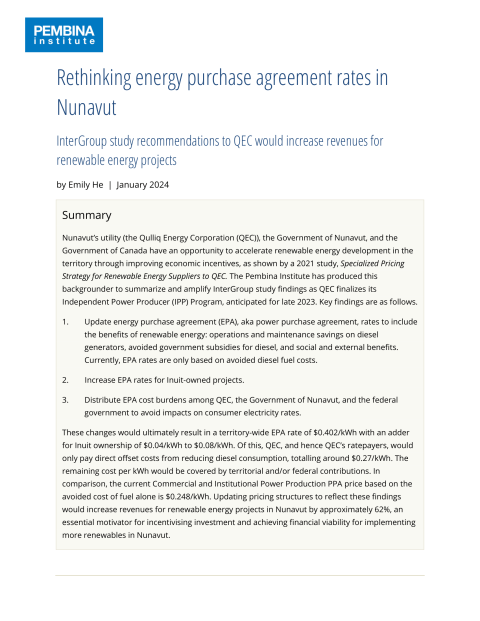Community-level and Indigenous-led action on renewable energy is building momentum in Nunavut. Despite growing interest on the part of business owners, communities, and project developers in this ongoing work, renewable energy development in the territory is slowed by a number of challenges — key among them Nunavut’s Independent Power Producer (IPP) policy and energy purchase agreement (EPA) pricing resulting in unfavourable economics for the transition from diesel to renewable energy.
The Pembina Institute has prepared this backgrounder to contextualize and summarize recent findings from a report commissioned by the territorial utility, the Qulliq Energy Corporation (QEC). These findings outline solutions that QEC, the Government of Nunavut, and the federal Government of Canada can undertake to accelerate progress and support Indigenous-led renewable energy development within remote communities in Nunavut. Key recommendations stemming from the report include:
- Update EPA pricing models to include the benefits of renewable energy – operations and maintenance savings on diesel generators, avoided government subsidies for diesel, and social and external benefits. Currently, EPA rates are only based on avoided diesel fuel costs.
- Increase EPA rates for Inuit-owned projects.
- Distribute EPA cost burdens between QEC, the Government of Nunavut, and the federal government to avoid electricity rate impacts.
These changes ultimately result in a territory-wide EPA rate of $0.402/kWh with an adder for Inuit ownership of $0.04/kWh to $0.08/kWh. In comparison, the current Commercial Institutional Power Production (CIPP) EPA price is $0.248/kWh. Updating pricing structures to reflect these findings would increase revenues for renewable energy projects in Nunavut by approximately 62%, an essential motivator for incentivising investment and achieving financial viability for implementing more renewables in Nunavut.
These findings could be transformative for Nunavut and for renewable energy projects across remote communities in Canada – a persistent question posed by utilities looking to offer higher EPA rates is: “How do we ensure customer electricity rates are not impacted?” This study poses a solution: governments provide top-ups to utility EPA rates. Federal, provincial, and territorial governments must collaborate with utilities in actualizing these mechanisms to unlock financial opportunities for Indigenous-owned renewable energy development in remote communities.
Implementing these findings is essential for fair and inclusive processes of energy development in Nunavut. Pembina experts are available to discuss these report findings and other questions related to renewable energy development within the territory.








